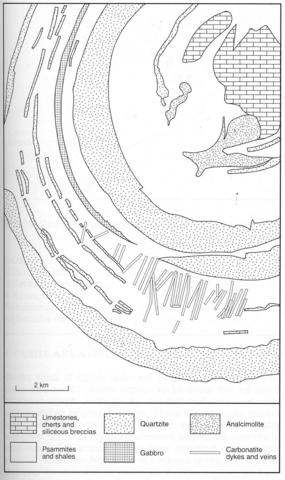stripes
Dietz et al. (1969) suggested that the Richat Dome is "probably the most striking earth structure so far photographed from near space". The dome is 38 km in diameter and comprises a series of circular ridges of outward dipping limestones, cherts, sandstones, quartzites and shales ranging in age from upper Precambrian towards the centre to lower Palaeozoic sandstones which cap the surrounding plateau. The dip gradually increases towards the centre where values of 35° obtain locally. The 'central eye' is occupied by flat-lying meta-arkose (Dietz et al., 1969) and is immediately encircled by a discontinuous massive ridge of chert and chert breccias. It has been suggested that the dome is an astrobleme and that it is of endogenic origin. Dietz et al. (1969) have shown convincingly that the former theory is incorrect. Blanc and Pomerol (1973) described dykes of dolerite, gabbro, diorite, oligoclasite, granite and aplite from the Tin Jouker area on the western side of the dome. Carbonate dykes found by them they ascribed to hydrothermal alteration of dolerite. Apart from a dolerite intrusion, thought to be a sill, described by Trompette (1973) and containing up to 8.25% K2O, none of these igneous rocks are alkaline. However, Woolley et al. (1984) described three radial carbonate dykes from the southwestern segment of the dome which they interpreted as carbonatite. Netto et al. (1992) describe a radial swarm of some 30 carbonatite dykes in the same area with many dykes over a kilometre in length, while they have also recognised two carbonatite necks in the central area of the dome. The carbonatites comprise granular ankerite, with up to 2.8% MnO, abundant somewhat rounded crystals of apatite, containing some cerium, euhedral magnetite, quartz and occasional barite. Tiny brown, isotropic crystals are probably pyrochlore but were too small to probe. The apatite contains an unusual and complex assemblage of primary fluid and solid inclusions which are discussed by Woolley et al. (1984). Whole rock chemical analyses indicate typical carbonatitic values for Sr, Ba, Nb and REE. In the central part of the dome are three areas underlain by analcime-rich rocks the origin of which is problematical. Woolley et al. (1984) cite previous work on these rocks which have been variously interpreted as extrusive volcanics with the analcime a primary magmatic mineral, hot spring deposits, lacustrine sediments and secondary deposits generated by replacement of rhyolite, rhyolitic tuffs or sediments. Netto et al. (1992) ascribe these rocks to an igneous origin. Barite mineralization is widespread in the central area. The mechanism of genesis of the dome is still a matter of debate, but it appears likely that it is underlain by an igneous complex and the similarity to the doming associated with many carbonatite complexes might suggest that carbonatite plays an important part in the story. A smaller dome (Semisyat) lies 45 km southeast of Richat, as can be seen on the Gemini photograph accompanying the paper by Dietz et al., 1969).
BLANC, P. and POMEROL, C. 1973. Presence de filons de roches carbonatees a analcime dans la depression de Tin Jouker, Richat, Adrar de Mauritainie. Comptes Rendus des Seances de l'Academie des Sciences. Paris, 265D: 2409-11.DIETZ, R.S., FUDALI, R. and CASSIDY, W. 1969. Richat and Semisyat domes (Mauritania): not astroblemes. Bulletin, Geological Society of America, 80: 1367-72.NETTO, A.M., FABRE, J., POUPEAU, G. and CHAMPENOIS, M. 1992. Datation par traces de fission de la structure circulaire des Richat (Mauritanie). Comptes Rendus de l'Académie des Sciences, Paris, 314 (Serie II): 1179-86.TROMPETTE, R. 1973. Pétrographie des Richât. A - Les dolérites de l'Ardrar de Mauritanie et le problème des analcimolites des Richât (Sahara occidentale). Sciences de la Terre. Mémoires. Nancy, 28: 83-95.WOOLLEY, A.R., RANKIN, A.H., ELLIOTT, C.J., BISHOP, A.C. and NIBLETT, D. 1984. Carbonatite dykes from the Richat Dome, Mauritania, and the genesis of the dome. The Indian Mineralogist (Sukheswala Volume), 189-207.

